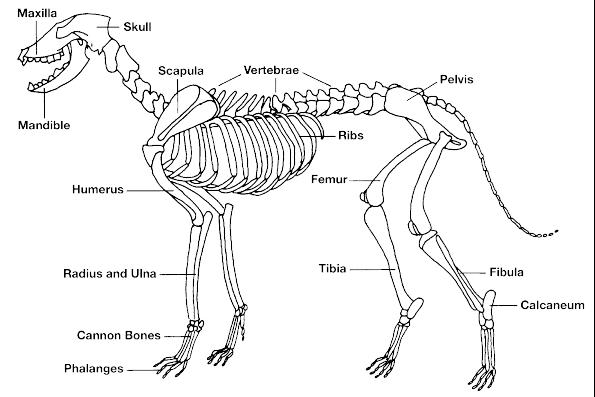 Early Civilizations:
Early Civilizations:
 Early Civilizations:
Early Civilizations:
Complex Societies of the New
and Old Worlds
Dr. Kathryn Denning
Anth 2150, Sept 2007 - Apr 2008
9 Oct 2007... Welcome!
Plan for the day
1 Guest presentation from York International!
Angela is an international student from Kenya and Elisabeth is a returned exchange student from England majoring in Anthropology.
For more information, contact Christee Karunairajan, York in the World Teams Facilitator, York International, 108 Vanier College, Tel: 416-736-5177, intlfun@yorku.ca
2 Admin/Announcements
3 Lecture: Review
Break
4 Lecture: Ancient technology, subsistence, and social life.
ADMIN/ANNOUNCEMENTS
Remember: Learning skills workshops for October: pdf.
QUIZ #1! There will be a Quiz in tutorial tomorrow, on October 10th. Review guidelines are posted here. It will be on everything we've done so far.
Writing Assignment 1 was handed out in class last week. It's due October 17 in tutorial. Follow instructions carefully. There are two handouts: Using Sources Correctly (click to download pdf), and Writing Assignment #1 (click to download pdf)
Tomorrow in tutorial:
a) you'll write the quiz
b) you'll return to the case of Otzi (whom we'll talk about a bit today)
REVIEW
Doing Archaeology: Sites and Methods
(referring to Ch 1-3: Introducing Archaeology and Prehistory, The Record of the Past, and Acquiring the Record)
This book is focused on taking you through 4 major developments in human prehistory:
- origins of humankind
- evolution of archaic humans like Homo erectus, origins of anatomically modern people like ourselves
- origins of more complex subsistence or food adaptations – food production
- origins of urbanized, literate civilization/state organized societies
Then, in the second part of the course we’ll go into more detail about those civilizations.
More specifically:
Table 1.1, pg 19 - "Major Developments in Human Prehistory"
AD 1532 - Spanish conquest of Peru
AD 600 - Classic Maya Civilization
27 BC to AD 395 - Roman Empire
3100 BC - origins of civilization, metallurgy
12 000 BP - origins of food production
c. 1500 BP - first settlement of the Americas
c. 45 000 BP - first settlement of Australia
150 000 BP - origins of modern humans
1.8 mya - Homo erectus in Africa and Asia
2.5 mya - Human origins
But how do we know anything at all about these developments? And what do we want to know about them?
The objectives of archaeology
Culture History – What Happened, Where, and When?
Ancient Lifeways – ancient human behaviour, i.e. people not artifacts. What did they do? How did they acquire food (subsistence), how did they relate to their natural environment, how did they interact with each other, what was their social organization, what were their religious beliefs?
Explaining Cultural Change – cultural processes, e.g. the emergence of agriculture and cities, the collapse of civilizations, the spread of new ones, how big cultural systems work and how people are agents of change within them
An Archaeologist’s Ethical Responsibilities
“The archaeologist has one primary and overriding priority: to preserve and conserve the material remains of the past for future generations. Archaeological sites and their contents are a unique record of our forebears in every part of the world…. this archive of the past, the archaeological record, is finite. Once disturbed or excavated, the record is gone forever. Conserving this priceless asset is our greatest responsibility to the past…” (Fagan 2007:31)
- n.b. we destroy evidence in the process of recovering it
p. 37
Stewardship
Consultation
Avoiding commercialization
Public education
Publication
Preservation
Care!
What kinds of sites do we have to work with?
There are many ways that people leave marks on the land.
- living/ habitation sites - rock shelters (caves), camps, houses, cities
- kill sites
- ceremonial sites
- burial sites
- trading/quarry sites
- art sites - e.g. rock art (http://en.wikipedia.org/wiki/Rock_art )
There are also other types of sites, e.g. preserved footprints
The Research Process (in an ideal world)

The Archaeological Record
Sites, features, artifacts
The nature of the record...

Preservation
... is VARIABLE!
RECOVERING EVIDENCE OF BODIES EVEN AFTER THE BODIES ARE GONE
e.g. Casts of people's bodies at Pompeii


"Magnetic memories. Skeletons  often dissolve when buried in acidic soils. Now archeologists have shown that they can detect long-decayed remains by measuring the faint magnetic signal left from hemoglobin and
other sources of iron, which microbes can magnetize. This image, published in the current issue of
Archaeological Prospection,
shows the magnetic signal from soil covering a roughly 1200-year-old Anglo-Saxon skeleton from Suffolk, United Kingdom. " (Science online, 2006)
often dissolve when buried in acidic soils. Now archeologists have shown that they can detect long-decayed remains by measuring the faint magnetic signal left from hemoglobin and
other sources of iron, which microbes can magnetize. This image, published in the current issue of
Archaeological Prospection,
shows the magnetic signal from soil covering a roughly 1200-year-old Anglo-Saxon skeleton from Suffolk, United Kingdom. " (Science online, 2006)
PRINCIPLE OF SUPERPOSITION

LAW OF ASSOCIATION IN ARCHAEOLOGY

METHODS OF RETRIEVING DATA
- accidental discoveries
- field survey
- remote sensing and GIS
- excavation (vertical, horizontal, test pits)
DATING
- relative chronology - placing things in order
- chronometric dating - actually knowing their chronological age
- recapping:
Before Christ /Before Common Era
Before Present
Anno Domine /Common Era
500 BC/BCE = 2507 BP ----- 0 BC/BCE/AD/CE -------------------- 2007 AD/CE
RELATIVE DATING: STRATIGRAPHY
Geological strata:
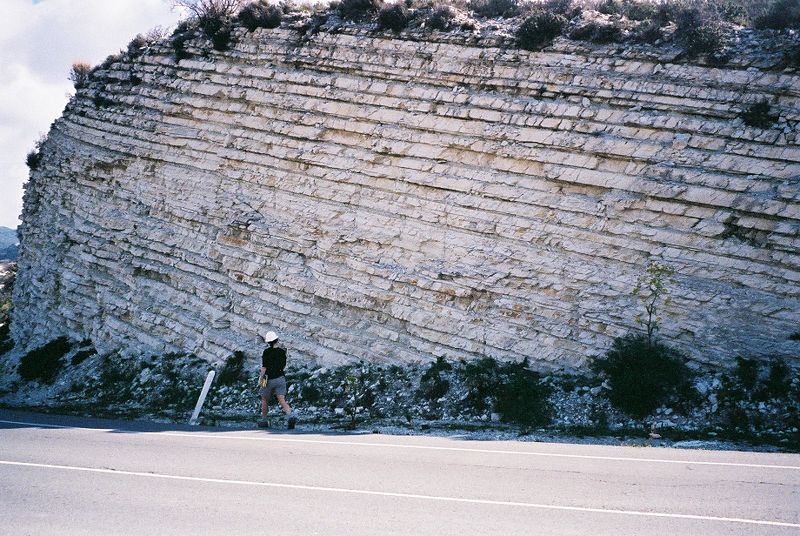
Stratigraphy in archaeology

OR: http://darkwing.uoregon.edu/~osma/lakecreek/lakecreek.htm
RELATIVE DATING METHOD: SERIATION

The major absolute/chronological (rather than relative) dating techniques
They're good for different date ranges.

Dendrochronology




Potassium-Argon
This is all about volcanoes...

Radiocarbon (C14) dating
It works because we're all made of star stuff!
It all starts with supernovas...

.... and cosmic rays... which are hitting you right now...

... which result in some of the carbon in every living thing being a radioactive form (C14) instead of the more usual C12...
... and when a living thing dies, the amount of C14 steadily decreases relative to the amount of C12... we measure that, and it gives us the amount of time that the animal or plant or person has been dead!
----------------
In archaeology, new methods are being developed every day, and refinements are being made to old methods.
e.g. DNA studies/ genome sequencing,
Remote sensing methods (p 63) include aerial photography, satellite imagery, ground-penetrating radar, infra-red photography, imaging radar from space, etc. (http://news.nationalgeographic.com/news/2006/11/061107-archaeology.html)
These techniques are used by specialists to help us recover more data, or do more with the data we already have.
But there will always be limits on exactly how much we can know for certain about ancient lives.
Ancient technology, subsistence, and social life.
General observations about people and their technology
- a complex dance between us and our things




Fagan Chapter 4, How Did People Live?
Topics there include....
Ancient Technologies
stone, bone, antler, wood, clay, metals, basketry, textiles
(n.b. invention of plastics is recent! mid-1800s onwards)
Classifying Artifact Types

Making Stone Tools
- two kinds - ground stone and chipped stone
- note the archaeological illustration conventions here of seeing all sides of the piece


Folsom Point
- making chipped stone tools is called 'knapping' (do not try this at home! or if you must, practice safe stone-working... wear protection)
- chipped stone tools can only be made from rocks that have a high silica content, often containing lots of tiny crystals. Flint, chert, basalt, quartz, obsidian (volcanic glass). They break like glass - conchoidal fracture... curved surfaces.
Below: Conchoidal Fracture in obsidian -- the 'point' is the place where the rock was initially struck -- the energy of the blow radiates outwards in a predictable way.
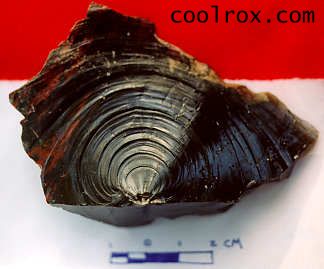
Three main methods of flint-knapping:
a) direct fracturing with a hammerstone
b) hammering with a soft hammer (bone)
c) pressure flaking with a punch
These methods each leave a specific fracture pattern -- thus archaeologists can tell how a tool was made!
Direct fracturing with a hammerstone

Making blades using a punch
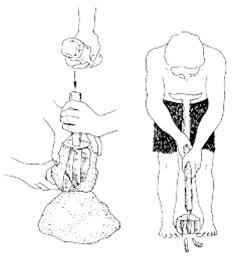
From Prepared Core to a Flake Tool
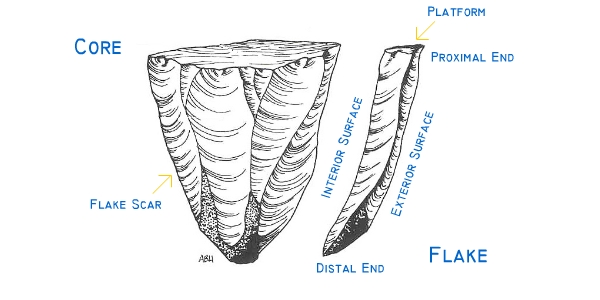
Illustration borrowed from: http://www.utexas.edu/courses/denbow/labs/lithic2.htm
Lithic Analysis
- i.e., what archaeologists do when they find stone tools or the waste flakes (debitage) left by the process of making stone tools
Aims of lithic analysis
- to understand the overall process of making and using stone tools (the chaîne opératoire or operational sequence) -- the stages of tool production from the acquisition of raw material to the making of the tool to the use of the tool to its abandonment... insight into human thought and behaviour
- to understand site formation and behaviour
Methods of lithic analysis include
- use-wear or edge-wear analysis
using a stone tool to cut things leaves distinctive marks on the tool - so archaeologists can figure out what it was used to cut, and how
e.g.s http://www.essex.ac.uk/psychology/rogerg/research/use%20wear/useWear.html
- petrological analysis
analysis of rock itself to locate the quarry (source) it came from... sometimes rock is traded very long distances!
- experimental archaeology
- core refitting
Core refitting
- best undertaken by the extremely patient
- reveals procedure used by knapper
- refitting flakes that are separated by a lot of space reveals activity patterns (e.g. start knapping in one place, then move to another, leaving the waste flakes behind)


Two pictures, same core. The 'slices' off the top are 'core tablets', to make a nice striking platform. The part on the left side is the flake made by striking downwards on that platform.
Below - a harder one... but they get much harder than that, too...

Images borrowed from: http://www.texasbeyondhistory.net/pavoreal/paleoindian.html
Other Ancient Technologies
made from...
bone, antler, wood, clay, metals, basketry, textiles
Attributes of Clay Vessels
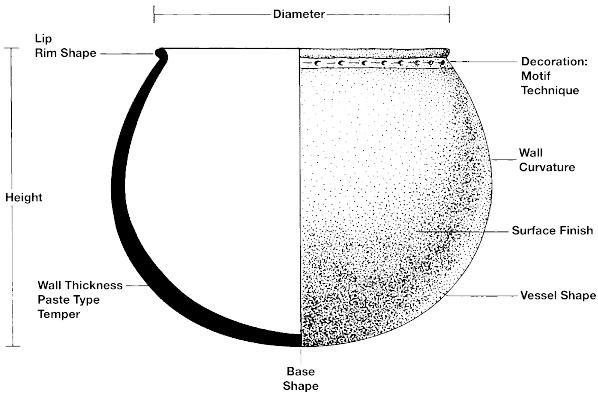
USES OF CLAY VESSELS IN THE PAST
ARCHAEOLOGICAL CONTEXTS OF CLAY VESSELS
WHAT WE CAN TELL FROM CLAY VESSELS: CONTENTS, AGE, SOURCE OF CLAY & TEMPER, AND SOMETIMES THE STYLE CAN TELL US ABOUT SOCIAL GROUPS
Subsistence: Making a Living
Why do we need to know about subsistence? Not just because it's good to know what people ate for dinner... but because obtaining food is a key organizing principle for a society.

Analyzing animal remains -- was the animal domesticated or wild, how much / what parts of it were eaten, which animals were eaten (species or which members of a species, e.g. young/male/female)
- can tell us about hunting strategies, etc.
Plant remains (flotation, etc.)
Fishing and fowling (birds), shellfish (e.g. clams)
Reconstructing Ancient Diet by examining human remains and feces too
* from the skeleton - carbon isotope analysis (C12/C13 for marine/land; C3/C4 for different plant types, indicating farming) and other stable isotopes (e.g. strontium)
* feces provide a very direct indicator of what people ate
Chapter 5: Individuals and Interactions
Some of this we'll return to next week.
We'll address the biological parts of studying burials a bit later... but first, it's important to take some time to consider the display and study of human remains.
Case study: Ötzi the "Ice Man", Fagan p 121
Clips from film "Return of the Iceman", from the NOVA series "Ice Mummies", 1998.
For tutorial tomorrow, come ready to discuss:
- what kinds of information have archaeologists been able to retrieve from Ötzi's body and belongings?
- what do you think about this kind of study of a dead human being?
- what would YOU most want to know about Ötzi?